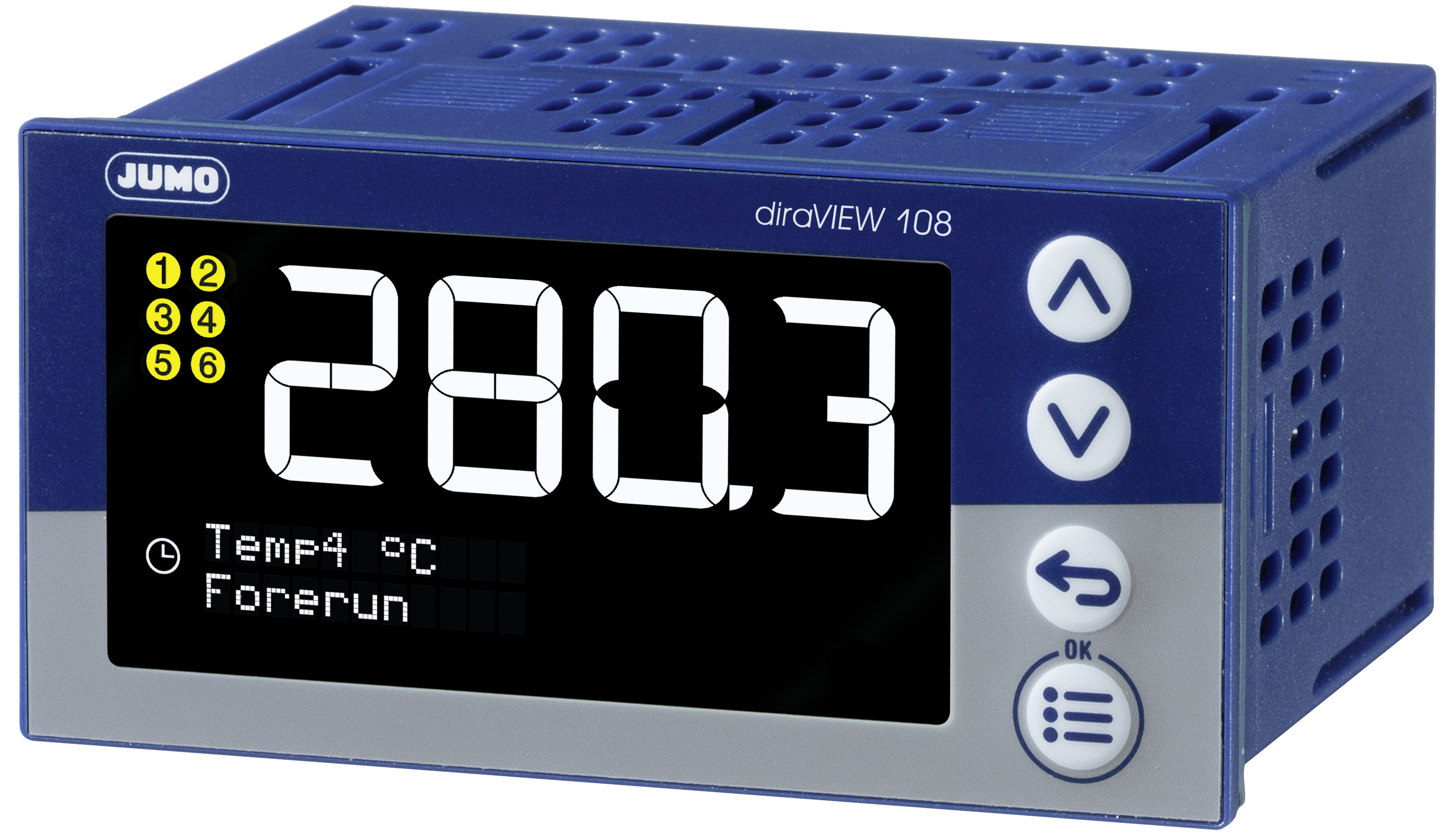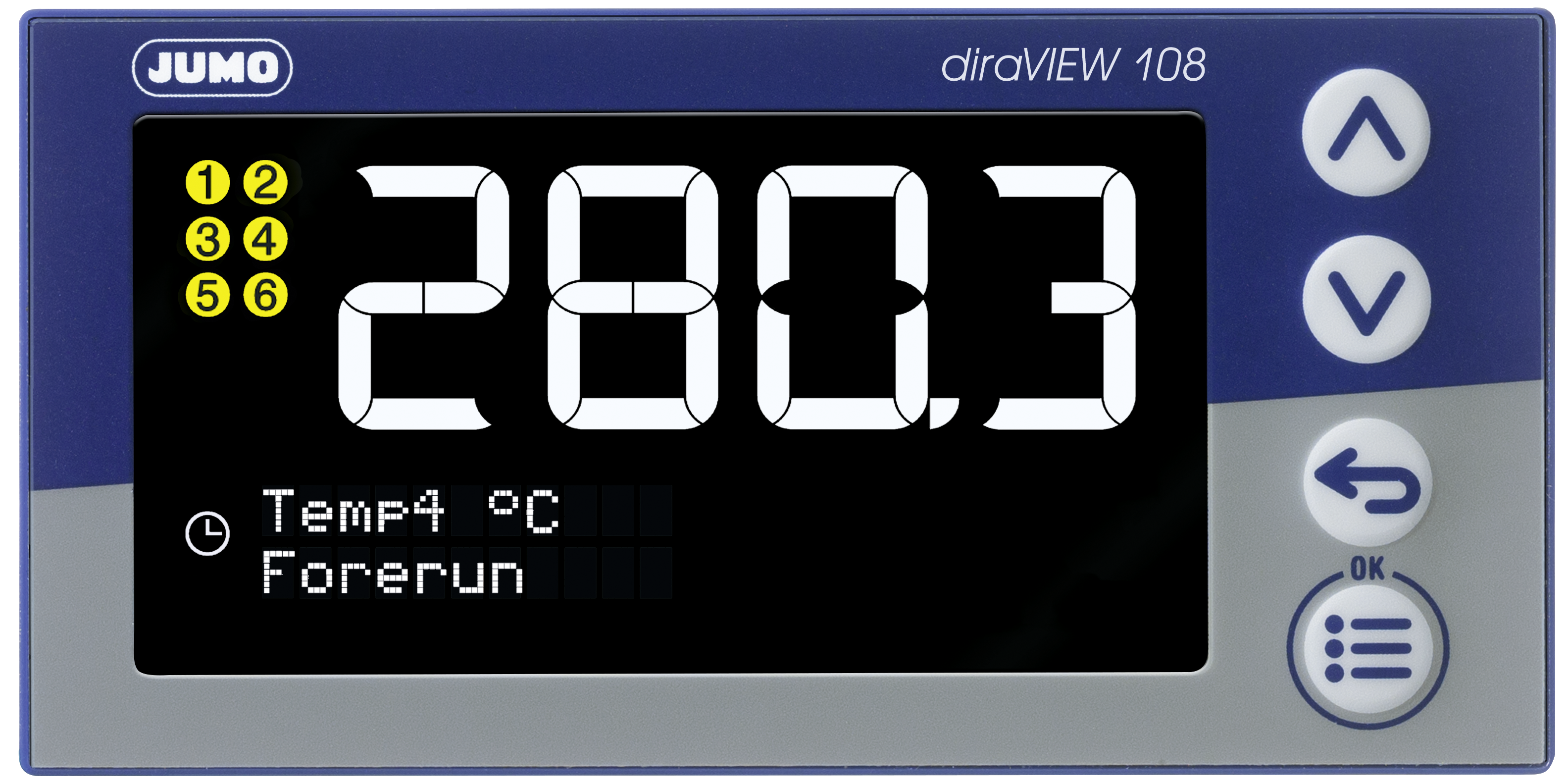JUMO diraVIEW 105 (Format 96 x 96 mm, 1 x Analogeingang, 2 x Relais, 1 x DI, 1 x DI / DO)

Description
Description "JUMO diraVIEW 105 (Format 96 x 96 mm, 1 x Analogeingang, 2 x Relais, 1 x DI, 1 x DI / DO)"
JUMO diraVIEW 108 - Digital indicator
- Version: Standard with factory settings
- Power supply: AC 110-240 V +10/-15%, 48 to 63 Hz
- Option 1-4: not assigned
- Extra code: without
- 1 analogue input
- 2 digital inputs (digital input 1 as an alternative to logic output)
- 1 relay (normally open contact)
- 1 logic output 0/14 V (alternative to digital input 1)
- Display and storage of min/max values
- Tare function
- Hold function
- Tare function for weighing applications
- Customised linearisation with the option of defining up to 40 value pairs or a polynomial
- Timer function
- Monitoring of 4 limit values
- Customised user levels
- Optional customised application using structured text (ST code)
- Optional maths and logic function
- Simple installation thanks to push-in technology
- Optional analogue output
- Optional RS485 or Ethernet interface
- Additional analogue and digital inputs via the interface
This digital indicator consists of five freely configurable and universally applicable devices in different DIN formats for displaying temperature, pressure and other process variables. The process variables and parameters are displayed on two 18-segment LCD displays. Types 701512, 701513 and 701514 are also equipped with a pixel matrix LCD display for displaying text. In addition, all devices have separate display elements for the switching positions of the outputs and the timer. They are operated via a membrane keypad with four buttons and are suitable for use in harsh environmental conditions thanks to their high IP65 protection rating.
Inputs and outputs
Each device type is equipped with a universal analogue input that is suitable for resistance thermometers, thermocouples, current, voltage, resistance transmitters and resistance/potentiometers. In addition, each device has a digital input, a switchable digital input/output.
With the exception of type 701510, which has one relay output (normally open contact) as standard, all other types have two relay outputs (normally open contact). The digital inputs are designed for connection with a potential-free contact. The digital output provides a logic signal from 0 to 14 V. Furthermore, additional optional
- Relay outputs (normally open contact)
- Logic outputs (0 to 14 V)
- PhotoMOS® relay outputs
- Analogue output (0 to 10V / 0 to 20 mA)
are available.
Certain inputs and outputs cannot be used simultaneously (see notes in the connection diagram)
Signal assignment via selectors
The input signals and all internal signals are available in so-called selectors (analogue selector, digital selector) for further use in the device. The control signals for the outputs are also assigned via selectors, which enables flexible assignment of signals and functions.
Interfaces
The device has a USB device interface (Micro-B socket on the rear), which is specially designed for connection to a PC for the setup programme. During configuration, the device is supplied with power via this USB interface so that no mains supply is required.
An optional RS485 interface is available, which is intended for communication with a Modbus master (Modbus RTU operating mode). The master can transmit up to two analogue values and two binary values to the device, which are used there as external input signals. In addition, two analogue flags and two digital flags (binary) are available. An Ethernet interface is also available as an option, which supports the Modbus TCP and Modbus RTU/ASCII operating modes via TCP. The same parameters and process values can be transmitted via this interface as via the RS485 interface.
Power supply
Two power supply variants are available:
- AC110 to 240 V
- AC/DC 20 to 30 V
48 to 63 Hz in each case
Electrical connection
Simple and time-saving connection using practical spring-loaded terminals (push-in technology)
Min-max function
Using the min-max function, the lowest and highest measured values are saved and continuously updated. It is possible to display these values separately or alternately with the current measured value. A binary signal makes it possible to reset the stored values and return them to the current measured value.
Hold function
The hold function "freezes" the value of the indicator, which means that this value is displayed for as long as the controlling binary signal is active.
Tare function
The tare function makes it possible to set the value of the indicator to zero, controlled by a binary signal (for weighing applications). The currently displayed value is added to the tare value each time. Another binary signal can be used to reset the tare value to zero so that the current value appears on the display again.
Limit value monitoring
The device has four limit value monitors, each with eight configurable alarm functions. Any analogue signal can be selected from a selector for monitoring. The limit values can either be absolute values or depend on another analogue signal. Various special functions are available, such as
- On/off delay
- Wiper function
- Alarm suppression during the switch-on phase or in the event of parameter changes
- Alarm latching
- Latching with acknowledgement
available.
These extensive functions enable flexible and precise realisation of alarm and limit value functions.
Digital control signals
This function enables the configuration of up to 4 digital control signals. The control signal is either formed by an AND/OR/XOR combination of up to three selectable binary signals or a single binary signal is used as an input signal and can be output as a pulsed signal, delayed signal, wiper signal or edge-triggered signal. In the latter case, the rising or falling edge of the binary signal is determined and the output signal is activated for the duration of a sampling interval. The output signal can be inverted in all these cases.
Timer
Once the timer is activated, an invertible signal is generated for the specified timer runtime. The timer can also be started after a lead time has elapsed or a tolerance limit has been reached. After the timer has elapsed, a timer end signal can be generated that is either time-limited or requires acknowledgement. These timer functions enable a wide range of time-dependent processes.
Service counter
The service counter can either count the number of switching operations of a binary signal or measure its switch-on duration. As soon as the adjustable limit value is reached, a binary signal is activated that must be acknowledged. An operating hours counter is also available, which records the operating time of the device.
Maths and logic function
The optional maths and logic function (extra code) can be used to link analogue or binary values. Up to four freely configurable maths or logic formulas can be created using the setup program. The results are then available for further use in the analogue or digital selector.
Individual user level
The individual user level offers space for up to 16 editable configuration parameters. These parameters can be selected individually in the setup programme.
Setup programme
With the setup programme, data records can be created, edited, transferred to the device and read out from there. The data can be saved and printed out. The programme also allows the user to easily create and print out a connection diagram showing the current terminal assignment of the device.
Startup: The startup function enables the recording of process variables during commissioning for a maximum of 24 hours. The recorded diagrams are available on the PC and can be used for system documentation, for example.
Online data: The current process variables of the device are displayed in a separate window.
Customer-specific linearisation
Individual linearisation according to customer requirements also makes it possible to use sensor signals with special characteristics. Programming is carried out in the setup program either using your value table with up to 40 value pairs or using a formula (4th order polynomial). The device supports 2 customer-specific linearisations.
Structured text
The "Structured text" option (extra code) allows the user to develop a customised application. This application is created using the ST editor, which is part of the setup programme, and uses the "Structured text" PLC programming language. Once completed, the application is transferred to the device and executed continuously. Online debugger functions are available in the ST editor for troubleshooting and testing.
With the help of the ST code, it is possible to display up to 10 stored text messages depending on the application.

